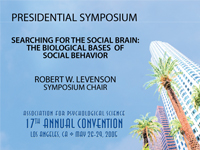Becoming Symbol-Minded
“Our symbolic ability is our defining characteristic of what it means to be a human being,” according to APS Fellow Judy DeLoache. “It’s what gives us our incredible cognitive power,” and is one of the core intelligence factors that separate people from animals.
But it doesn’t come naturally. Learning to distinguish symbols from the objects they represent is one of the hardest psychological challenges that young children must overcome.
In her talk, “Becoming Symbol-Minded,” the APS 17th Annual Conference’s “Bring The Family Address,” DeLoache described this challenge and displayed humorous videos of some of the missteps that children make along the way to being full-fledged symbol users.
She began her talk with the story of Pygmalion, a Greek artist who ended up falling in love with the sculpture of a beautiful woman he created. Many children fall prey to the Pygmalion problem, according to DeLoache. They often cannot comprehend the idea of a symbol: something intended to represent something other than itself.
DeLoache’s experiments in her laboratory at the University of Virginia illustrate various ways in which children fall prey to the Pygmalion problem. She showed one video of an experiment in which a 9-month-old child tried to put his mouth on the picture of a bottle. In this experiment, the child understood the content of the picture, but was unable to understand its symbolic representation. “They just don’t have experience with pictures,” DeLoache said. “They are confusing a symbol, which is a picture, with the referent.”
DeLoache also showed a video of a same-aged child in a foreign country falling victim to the same confusion — proving that the Pygmalion problem is cross-cultural.
In a more elaborate experiment, two rooms were set up that looked exactly the same, with similar looking furniture in each — except that one room was large and the other was much smaller. In the experiment, 2 1/2-year-old children were shown the location of an object hidden in the small room, and were asked to travel into the larger room and locate the object. For most of the children this task was difficult and they were unable to find the object in the larger room, DeLoache said.
“The age difference in this task is attributed to the difficulty young children have achieving ‘dual representation.’ The younger the children, the more inclined they are to focus on the concrete object itself rather than its relation to what it represents,” DeLoache said.
In her laboratory, DeLoache has also studied how children will treat small replica objects as though they were regularsized — for example by trying to sit on tiny chairs or somehow climb into small toy cars.
According to DeLoache, these experiments are important in understanding how children become symbol-minded, which is an issue of growing importance: New technology presents children with an ever-growing number of symbols. “Children have to master an enormous array of different kinds of symbols,” she said, “so it’s important to study how they go about doing that and what the challenges are.”



APS regularly opens certain online articles for discussion on our website. Effective February 2021, you must be a logged-in APS member to post comments. By posting a comment, you agree to our Community Guidelines and the display of your profile information, including your name and affiliation. Any opinions, findings, conclusions, or recommendations present in article comments are those of the writers and do not necessarily reflect the views of APS or the article’s author. For more information, please see our Community Guidelines.
Please login with your APS account to comment.